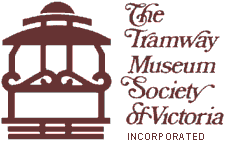
| About TMSV | Visitor information | Our collections |
Current projects | Feature articles | Join TMSV | Useful links | TMSV news |
 |
|||||||||
|
|||||||||
Keeping time: Bundy clocks in the M&MTBIn the days before trams carried automatic vehicle monitoring transponders linked electronically back to central control centres, there was a need to track if trams were running to schedule — and to determine if their crews were completing their shifts. On the M&MTB tram system, this was achieved via the use of Bundy clocks.
The TMSV is fortunate to have an example of an M&MTB time recording clock on display in the Exhibition Shed. Manufactured by the Cincinnati Time Recorder Company of Cincinnati Ohio, USA [1], it is a typical example of a time recording clock used in Melbourne, complete with the M&MTB tramway green casing. Clocks manufactured by other companies were also used by the M&MTB, but it is likely that this particular time recorder clock was used on the Port Melbourne to Bulleen omnibus route. Each tram driver was issued a Bundy key which was embossed with the depot letter and the run number [2] for his shift. On arriving at a timing point, usually at an end of section tram stop, the driver would hop down from the tram, and insert the Bundy key into the appropriate slot and give it a quick twist. This would force a paper tape against the embossed key and the time recording equipment, printing the time and run number on the tape. It was the inspector’s job to wind up the Bundy clock and remove the tape for transport back to the depot where it could be checked to ensure that trams were running to time, and that drivers were completing all their trips to schedule. As the M&MTB was a classic example of a vertically integrated organisation, all maintenance of its Bundy clocks was performed in-house by two staff in a small workshop located in Head Office at 616 Little Collins Street, Melbourne. This required a few spare Bundy clocks to be held in store, so that they could be rotated into service when performing scheduled maintenance. From the 1960s, non-standard Bundy clocks such as the example held by the TMSV were retired and replaced with a single model, leaving only one type in service. Most of the Bundy clocks have now been removed from the Melbourne tramway system, but there are still one or two in place [3] — a memory of a work practice now made obsolete by the Information Revolution. A Bundy clock was restored in 2006 to commemorate one hundred years of electric trams in Melbourne, and can be seen in the office at Essendon Depot, the oldest operating tram depot in Melbourne. BibliographyBundy Arts & Victorian Museum — Timeline
of the Bundy Manufacturing Company Footnotes[1] The Cincinnati Time Recorder Company was founded in 1896 and existed as an independent company until it was acquired in 1991 by the Amano Corporation of Japan. It now operates as Amano Cincinnati Inc. [2] Run numbers were displayed on each tram with a small yellow plate held against the driver's windscreen, showing the depot letter and run number in black writing - for example, run K 52 belonged to Kew Depot. Depot letters were as follows:
Southbank Depot was never allocated a depot letter, as it was opened after the introduction of Automatic Vehicle Monitoring. [3] A Bundy clock was still in place in 2007 at the Arts Centre stop in St Kilda Road, located above the Alexandra Avenue underpass.
|
![]() Last
updated 16
May 2007.
Last
updated 16
May 2007.
![]() Content
copyright © Russell
Jones 2007. Reproduced with permission.
Content
copyright © Russell
Jones 2007. Reproduced with permission.